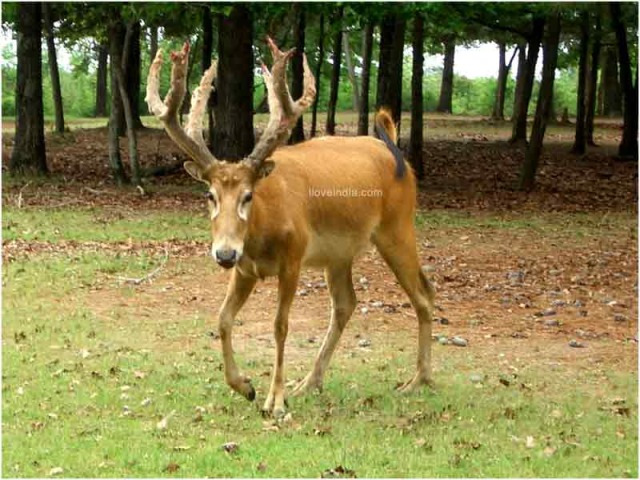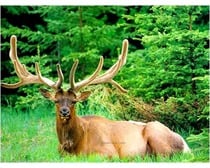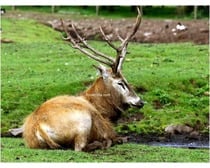Pere David’s deer is beautiful animal that has re-emerged after being almost extinct. Read on to find some more interesting facts & amazing information on this animal.
Facts About Pere David’s Deer
Pere David’s deer, or Milu in Chinese, belongs to the genus Elaphurus and is native to the subtropics of China. This mammal has almost rescued from the brink of extinction, owing to the widespread effort of Father Armand David, who was running a French missionary in China. He came to know of the only surviving herd of the animal, in a preserve belonging to the Chinese emperor. He managed to expose their survival, after which a few animals were illegally transported to European countries and bred there for the preservation of species. The breed has, thus, derived its name from its saver, Father (‘Pere’ in French) David and is known as Pere David’s deer worldwide. This species of deer is characterized by branched antlers, heavy legs, large eyes, broad hooves, relatively small ears, and a long, bushy tail. The animal loves water and is a great swimmer. Read on to know some more interesting facts and amazing information about Pere David’s deer.

Facts About Pere David’s Deer
Kingdom: Animalia
Phylum: Chordata
Subphylum: Vertebrata
Class: Mammalia
Order: Artiodactyla
Family: Cervidae
Subfamily: Cervinae
Genus:Elaphurus
Species: E. davidianus
Height: 45 inch (1.15 m)
Weight: male- 250 kg (540 lb) / female- 140 kg (301 lb)
Lifespan: Up to 23 years
Diet: grass and water plants in summers, reeds and leaves of bushes
Range: Subtropics of China, zoos around the world
Habitat: Low lying grasslands, seasonally flooded areas like Yangtze River valley and coastal marshes
Age of Sexual Maturity: 14 months
Gestation Period: 9 months
Number of Offspring: 1 or 2
Interesting & Amazing Information On Pere David’s Deer
- Pere David’s deer traditional name is ‘sze pu shiang’, which means ‘none of the four’. This animal seems to be a mixed breed, with hoofs of a cow, antlers of a deer, tail of a donkey and neck of a camel.
- Due to its traditional name, Pere David’s deer has received an admission into Chinese mythology as the mount of Jiang Ziya in Fengshen Yanyi, which was written in the Ming dynasty.
- The deer has white underparts and a reddish tan coat that becomes woollier and dark grey in the winter.
- The males grow two pairs of antlers per year. The largest set is developed in summers and shed in rutting season, in November. The second set of antlers develops in January and is dropped a few weeks later.
- The long slender hooves of Pere David’s deer allow it to walk comfortably on marshy and soft land.
- It was in 1800 that Father David became the life saver of the deer and with his efforts; many of them were illegally transported to European zoos, where they were bred.
- Several Pere David’s deer were killed because of a disastrous flood in 1895. The rest of the deer, which were living in Imperial Park, were killed for food, by both Western and Chinese soldiers, during Boxer Rebellion. The deer was then bred in captivity at Woburn Abbey in England under the care of the duke of Bedford.
- Today, the deer survives in zoos and game parks around the world. It has, however, remained extinct in its native sub-tropical wet areas of China, for almost 100 years.
- Pere David’s deer was re-introduced in China in the late 1980s, in Nanhaizi Milu Park, Beijing and Dafeng Reserve, Jiangsu Province.
- Out of 1500 Pere David’s deer worldwide, 600 still live on the estate of Duke of Bedford.


See also
More from iloveindia.com
- Home Remedies | Ayurveda | Vastu | Yoga | Feng Shui | Tattoos | Fitness | Garden | Nutrition | Parenting | Bikes | Cars | Baby Care | Indian Weddings | Festivals | Party ideas | Horoscope 2015 | Pets | Finance | Figures of Speech | Hotels in India : Delhi | Hyderabad | Chennai | Mumbai | Kolkata | Bangalore | Ahmedabad | Jaipur
- Contact Us Careers Disclaimer Privacy Policy Advertise With Us Lifestyle Sitemap Copyright iloveindia.com. All Rights Reserved.





